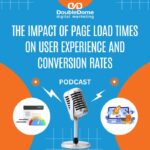By admin

In this episode, we delve into the critical role of page load times in shaping user experience and influencing conversion rates.
Key topics discussed include:
-
Understanding Page Load Times:
-
Definition and significance of page load times in the context of web performance.
-
Overview of metrics used to measure page load speed.
-
-
Impact on User Experience:
-
User Expectations: Exploring how modern users anticipate quick access to web content and the effects of delays on their behavior.
-
Bounce Rates: Analyzing the correlation between slow-loading pages and increased bounce rates, where users leave the site prematurely.
-
Perception of Professionalism: Discussing how sluggish websites can lead to negative perceptions about a company’s credibility and professionalism.
-
-
Effect on Conversion Rates:
-
Sales and Lead Generation: Examining how delays in page loading can hinder sales, lead generation, and other desired user actions.
-
Revenue Implications: Highlighting the potential revenue loss for e-commerce platforms due to slow page speeds.
-
Positive Outcomes of Optimization: Illustrating how improving load times can enhance user engagement and boost conversion rates.
-
-
Strategies for Optimizing Page Load Times:
-
Image Compression: Utilizing image compression tools to reduce file sizes without compromising quality.
-
Browser Caching: Implementing caching techniques to store website elements locally on users’ devices for faster subsequent access.
-
Minimizing HTTP Requests: Reducing the number of server requests by combining files and optimizing code.
-
Content Delivery Networks (CDNs): Leveraging CDNs to distribute website content across multiple servers globally, decreasing load times for users in various locations.
-
Responsive Web Design: Ensuring the website is mobile-friendly to cater to users on different devices, particularly those on slower networks.
-
By understanding and addressing the factors affecting page load times, businesses can significantly enhance user satisfaction, reduce bounce rates, and improve overall conversion rates.








